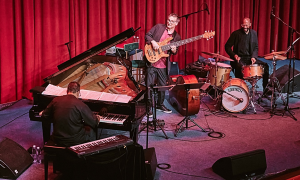Home » Jazz Articles » Profile » Kent Carter
Kent Carter
...The most important thing is to make everything around you as beautiful as possible.
 There are those improvisers who find Europe both a financially more stable climate as well as an aesthetic challenge. Steve Lacy and his regular bassist for almost 20 years, Kent Carter, are a prime example. Carter, while certainly his own musician with a unique conception, is in some ways inextricably tied to Lacy, for the path to musical freedom was reached through the open door of European improvisation.
There are those improvisers who find Europe both a financially more stable climate as well as an aesthetic challenge. Steve Lacy and his regular bassist for almost 20 years, Kent Carter, are a prime example. Carter, while certainly his own musician with a unique conception, is in some ways inextricably tied to Lacy, for the path to musical freedom was reached through the open door of European improvisation. Carter was born June 14, 1939 in New Hampshire, though he was raised in Vermont. Starting on cello and bassoon, his woody tone came naturally, as did an interest in strings. His father was a violist and the director of the state-subsidized Vermont Symphony Orchestra, and following brief attention to the banjo and electric bass, Carter switched to the upright in the '50s: "I had to help out in a dance band playing college campuses and stuff like that. In the old days, the sorority houses used to hire bands for the weekend parties. It was very exciting and my first exposure to playing something in the jazz world. From there, I wanted to get a good bass and study." Carter worked as much as he could in the jazz environment that was Vermont at the time, but it was familial obligations that finally sent him to Boston in the late '50s: "I went down to Boston to go to one of those IBM technical schools for two months and ended up working at a bank, so I moved my family down there and so forth. I started studying at the Berklee School of Music, and Herb Pomeroy ran the recording band. He asked me if I would like to play in the band, and he arranged that I could take all the courses that I wanted to for a year, if I did all the recordings." Though interested in and exposed to modern jazz in Vermont and at Berklee, it was an encounter with legendary Boston pianist, percussionist and theorist Lowell Davidson that brought Carter into the jazz vanguard, for working with Lowell brought Carter to New York.
Lowell and Carter worked in a progressive trio with variously Billy Elgart, Milford Graves or Paul Motian in the drum chair, and it was an aggregation of this trio that played the October Revolution in Jazz at the Cellar Café in 1964. An explosion of the new jazz' most creative minds, Carter met trumpeter/composer Mike Mantler and Paul and Carla Bley during this period, and regular work with this triumvirate led to gigs with the nascent Jazz Composers' Orchestra as well as a European tour with Paul Bley and drummer Barry Altschul, playing in Berlin and Copenhagen's Café Montmartre. Through these connections, the most fruitful partnership of Carter's career developed, for his tenure with soprano saxophonist Steve Lacy began in 1965: "[Lacy] had this incredible sound, more lyric in a way, but very, very hip. It stood out and could burn through the biggest sound you could believe - it's like gold." The two embarked on a trip to Germany for which few of the promised gigs stayed open, and the bassist returned to New York in 1966 - but not before connecting with trumpeter Enrico Rava, drummer Aldo Romano and vibraphonist Karl Berger for Lacy's "The Precipitation Suite". This connection with some of the movers and shakers of European improvisation in the '60s led to Carter's return to the Continent in 1969, hooking up once again with Lacy. Apart from the brief interruption early on, the bassist stayed in this group in one form or another until 1982; they were often joined by altoist Steve Potts, cellist/violinist/vocalist Irene Aebi, pianists Mal Waldron and Bobby Few and drummers Noel McGhie and Oliver Johnson. Going from Monk to freedom came naturally for Lacy and for the group: "Lacy wanted openness; he wanted to move out of something and get into another something. He wanted to move. He went through this period, and we all did, of working from scratch, just playing. Out of that came his composing; he started to compose."
 In stark contrast to his work with Lacy, which, though at times seemingly "free" was rather structured, Carter was hired for the bass chair in John Stevens' Spontaneous Music Ensemble. The SME was a free music group in which "the conception was no conception. His thing was to sit down and make music with no clichés, just through interaction and listening. So this sound developed which was quite exciting once it got going. It wasn't so easy at first because you didn't have anything to hold onto." Rather than playing from the conception of a loose tune or at least a familiar pace, the SME taught the improviser to just "play" gradually letting the music happen as it progressed. Playing for the ensemble rather than the self is central to Carter's philosophy. Choosing to eschew solo playing other than for the good of working on his own string conception, the goal comes to be "working for the collective so that you make other people sound good, and you sound good yourself. But the most important thing is to make everything around you as beautiful as possible. Out of that, you find your voice. Soloing - I'm not a great soloist. Lacy developed that beautifully, but I've done some solos and I find it very difficult." Solo and overdubbed bass and cello work makes up most of Beauvais Cathedral , his 1974 Emanem effort, a home-recorded investigation of dense, turgid drones and lithe pizzicato that serves as a window on his process. At present, string investigation for Carter has gone beyond one-man process pieces to a cooperative string trio, currently featuring violinist Albrecht Maurer and violist Katrin Mickiwicz (who had replaced wizard Portuguese violinist Carlos Zingaro).
In stark contrast to his work with Lacy, which, though at times seemingly "free" was rather structured, Carter was hired for the bass chair in John Stevens' Spontaneous Music Ensemble. The SME was a free music group in which "the conception was no conception. His thing was to sit down and make music with no clichés, just through interaction and listening. So this sound developed which was quite exciting once it got going. It wasn't so easy at first because you didn't have anything to hold onto." Rather than playing from the conception of a loose tune or at least a familiar pace, the SME taught the improviser to just "play" gradually letting the music happen as it progressed. Playing for the ensemble rather than the self is central to Carter's philosophy. Choosing to eschew solo playing other than for the good of working on his own string conception, the goal comes to be "working for the collective so that you make other people sound good, and you sound good yourself. But the most important thing is to make everything around you as beautiful as possible. Out of that, you find your voice. Soloing - I'm not a great soloist. Lacy developed that beautifully, but I've done some solos and I find it very difficult." Solo and overdubbed bass and cello work makes up most of Beauvais Cathedral , his 1974 Emanem effort, a home-recorded investigation of dense, turgid drones and lithe pizzicato that serves as a window on his process. At present, string investigation for Carter has gone beyond one-man process pieces to a cooperative string trio, currently featuring violinist Albrecht Maurer and violist Katrin Mickiwicz (who had replaced wizard Portuguese violinist Carlos Zingaro). It is probably a moot point to wonder whether Kent Carter would have found the truly "open music" had he stayed in the US. A cutthroat scene of nervous energy-music is a far cry from the old-world patience that begets studied movements. Regardless of the accuracy of such stereotypes, it is that vital synthesis of European and American mettles that produces the most interesting music of the jazz canon.
Related Article
Kent Carter and the Continental Continuum
Tags
PREVIOUS / NEXT
Support All About Jazz
 All About Jazz has been a pillar of jazz since 1995, championing it as an art form and, more importantly, supporting the musicians who make it. Our enduring commitment has made "AAJ" one of the most culturally important websites of its kind, read by hundreds of thousands of fans, musicians and industry figures every month.
All About Jazz has been a pillar of jazz since 1995, championing it as an art form and, more importantly, supporting the musicians who make it. Our enduring commitment has made "AAJ" one of the most culturally important websites of its kind, read by hundreds of thousands of fans, musicians and industry figures every month.

































